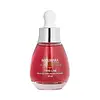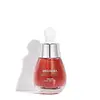What's inside
What's inside
 Key Ingredients
Key Ingredients

 Benefits
Benefits

 Concerns
Concerns

No concerns
 Ingredients Side-by-side
Ingredients Side-by-side

Rosa Centifolia Flower Water
Skin ConditioningGlycerin
HumectantHydrolyzed Collagen
EmollientNatto Gum
Wheat Amino Acids
Skin ConditioningPanax Ginseng Root Extract
EmollientOphiopogon Japonicus Root Extract
Skin ConditioningPlatycodon Grandiflorus Root Extract
AntioxidantGlycyrrhiza Glabra Root Extract
BleachingAstragalus Membranaceus Root Extract
EmollientZingiber Officinale Root Extract
MaskingLonicera Japonica Flower Extract
Skin ConditioningZanthoxylum Piperitum Fruit Extract
Skin ConditioningPulsatilla Koreana Extract
Skin ConditioningCitrus Paradisi Fruit Extract
Skin ConditioningSodium Hyaluronate
HumectantDioscorea Opposita Root Extract
Skin ConditioningHydroxyethylcellulose
Emulsion StabilisingGardenia Florida Oil
TonicTremella Fuciformis Sporocarp Extract
AntioxidantAcetyl Hexapeptide-8
HumectantXanthan Gum
EmulsifyingAdenosine
Skin ConditioningDisodium EDTA
Rosa Centifolia Flower Water, Glycerin, Hydrolyzed Collagen, Natto Gum, Wheat Amino Acids, Panax Ginseng Root Extract, Ophiopogon Japonicus Root Extract, Platycodon Grandiflorus Root Extract, Glycyrrhiza Glabra Root Extract, Astragalus Membranaceus Root Extract, Zingiber Officinale Root Extract, Lonicera Japonica Flower Extract, Zanthoxylum Piperitum Fruit Extract, Pulsatilla Koreana Extract, Citrus Paradisi Fruit Extract, Sodium Hyaluronate, Dioscorea Opposita Root Extract, Hydroxyethylcellulose, Gardenia Florida Oil, Tremella Fuciformis Sporocarp Extract, Acetyl Hexapeptide-8, Xanthan Gum, Adenosine, Disodium EDTA
Rosa Damascena Flower Water
MaskingWater
Skin ConditioningDipropylene Glycol
HumectantButylene Glycol
HumectantGlycerin
HumectantAmmonium Acryloyldimethyltaurate/Vp Copolymer
Panthenol
Skin ConditioningGlycosyl Trehalose
Emulsion StabilisingPEG-60 Hydrogenated Castor Oil
EmulsifyingHydroxyacetophenone
AntioxidantHydrogenated Starch Hydrolysate
HumectantRosa Damascena Flower Oil
MaskingGardenia Taitensis Callus Extract
AntioxidantSodium Hyaluronate
HumectantCarrageenan
Dextrin
AbsorbentEthylhexylglycerin
Skin ConditioningCarnosine
Skin ConditioningAdenosine
Skin ConditioningSodium Polyacrylate
AbsorbentPvm/Ma Copolymer
Emulsion StabilisingZingiber Officinale Root Extract
MaskingOphiopogon Japonicus Root Extract
Skin ConditioningPanax Ginseng Root Extract
EmollientHydrolyzed Grape Fruit Extract
HumectantOenothera Biennis Flower Extract
AstringentHydrolyzed Collagen
EmollientTremella Fuciformis Sporocarp Extract
AntioxidantAcetyl Hexapeptide-8
Humectant1,2-Hexanediol
Skin ConditioningPalmitoyl Tetrapeptide-7
Skin ConditioningCopper Tripeptide-1
Skin ConditioningPalmitoyl Tripeptide-1
Skin ConditioningPalmitoyl Pentapeptide-4
Skin ConditioningRosa Damascena Flower Water, Water, Dipropylene Glycol, Butylene Glycol, Glycerin, Ammonium Acryloyldimethyltaurate/Vp Copolymer, Panthenol, Glycosyl Trehalose, PEG-60 Hydrogenated Castor Oil, Hydroxyacetophenone, Hydrogenated Starch Hydrolysate, Rosa Damascena Flower Oil, Gardenia Taitensis Callus Extract, Sodium Hyaluronate, Carrageenan, Dextrin, Ethylhexylglycerin, Carnosine, Adenosine, Sodium Polyacrylate, Pvm/Ma Copolymer, Zingiber Officinale Root Extract, Ophiopogon Japonicus Root Extract, Panax Ginseng Root Extract, Hydrolyzed Grape Fruit Extract, Oenothera Biennis Flower Extract, Hydrolyzed Collagen, Tremella Fuciformis Sporocarp Extract, Acetyl Hexapeptide-8, 1,2-Hexanediol, Palmitoyl Tetrapeptide-7, Copper Tripeptide-1, Palmitoyl Tripeptide-1, Palmitoyl Pentapeptide-4
Alternatives
Ingredients Explained
These ingredients are found in both products.
Ingredients higher up in an ingredient list are typically present in a larger amount.
Acetyl Hexapeptide-8, commonly known as Argireline or Acetyl Hexapeptide-3, is a popular peptide in skincare. It’s often referred to as a “Botox-like” ingredient because it helps reduce muscle movement.
By relaxing these micro-movements, Argireline may help minimize the appearance of fine lines and wrinkles. That said, it’s not as powerful as Botox, and research on its long-term effectiveness is still limited.
Beyond smoothing, Argireline may also support collagen production. Collagen is the protein that helps keep your skin firm, bouncy, and well-hydrated by strengthening the skin barrier.
So while Argireline isn’t a miracle fix, it can be a helpful addition to a routine focused on both prevention and skin health.
Read more about other common types of peptides here:
Learn more about Acetyl Hexapeptide-8Adenosine is in every living organism. It is one of four components in nucleic acids that helps store our DNA.
Adenosine has many benefits when used. These benefits include hydrating the skin, smoothing skin, and reducing wrinkles. Once applied, adenosine increases collagen production. It also helps with improving firmness and tissue repair.
Studies have found adenosine may also help with wound healing.
In skincare products, Adenosine is usually derived from yeast.
Learn more about AdenosineGlycerin is already naturally found in your skin. It helps moisturize and protect your skin.
A study from 2016 found glycerin to be more effective as a humectant than AHAs and hyaluronic acid.
As a humectant, it helps the skin stay hydrated by pulling moisture to your skin. The low molecular weight of glycerin allows it to pull moisture into the deeper layers of your skin.
Hydrated skin improves your skin barrier; Your skin barrier helps protect against irritants and bacteria.
Glycerin has also been found to have antimicrobial and antiviral properties. Due to these properties, glycerin is often used in wound and burn treatments.
In cosmetics, glycerin is usually derived from plants such as soybean or palm. However, it can also be sourced from animals, such as tallow or animal fat.
This ingredient is organic, colorless, odorless, and non-toxic.
Glycerin is the name for this ingredient in American English. British English uses Glycerol/Glycerine.
Learn more about GlycerinHydrolyzed collagen has a misleading name because it is actually a mixture of various proteins/peptides. This ingredient has skin hydrating properties.
Collagen is the most abundant type of structural protein found in your body. In your skin, it is responsible for keeping it firm and youthful.
Hydrolyzed Collagen is created by breaking up proteins into smaller peptide bonds. These peptides act as humectants and emollients.
Humectants are great at holding onto water, keeping skin hydrated. Emollients create a thin barrier on the skin to prevent moisture from escaping.
There is ongoing debate about whether hydrolyzed collagen works because it increases skin hydration. Skin hydration is also linked to elasticity and the appearance of wrinkles.
Collagen or peptide ingredients can be used in the morning or night. They will not increase sun sensitivity, but you should always wear sunscreen during the day.
According to a manufacturer, this ingredient is a great hair conditioner as well.
This ingredient can be extracted from different sources, including:
Vegan collagen is derived from yeast, bacteria, or plant sources. Vegan collagen would go by a different INCI name, such as hydrolyzed soy protein.
The results are varied.
A study from 2021 found hydrolyzed collagen increased elasticity and improved wrinkles in 1,125 participants between age 20 and 70. Another study found increased skin thickness in participants between the ages of 45 to 59.
However, It is difficult to prove that oral collagen will end up working on your skin. Many of the studies using hydrolyzed collagen also add several vitamins and nutrients into the test mixture as well.
Further studies are needed at this time.
Learn more about Hydrolyzed CollagenWe don't have a description for Ophiopogon Japonicus Root Extract yet.
Ginseng root is a well-loved ingredient in Asian skincare for good reason. It hydrates the skin, soothes irritation, and helps even out skin tone.
In traditional East Asian medicine, ginseng has been used for centuries both as food and as a healing remedy, and modern research continues to confirm its skin benefits.
One of the standout features of ginseng is its ability to improve blood circulation and oxygen delivery to the skin, bringing a fresh supply of nutrients to support overall skin health. It also has antioxidant and anti-inflammatory properties. This helps to protect your skin against damage from UV exposure, pollution, and daily stress.
Additionally, studies suggest that ginseng may help reduce hyperpigmentation by inhibiting tyrosinase, the enzyme involved in melanin production.
There are different types of ginseng used in skincare, and while they all share core benefits, their potency can vary.
Most products use fresh or white ginseng because it’s more affordable. However, red ginseng, produced by steaming the root, contains higher levels of ginsenosides, which are compounds with proven anti-aging effects. These ginsenosides help reduce the appearance of wrinkles and improve skin elasticity.
Note: All forms of ginseng are listed simply as “Panax ginseng” in ingredient lists. We recommend reaching out to the brand if you have questions about which type of ginseng is used in their ingredients.
For general antioxidant benefits, any ginseng extract will do, but for wrinkle care or firmer skin, red or fermented ginseng is often more effective.
In short, ginseng is a powerhouse ingredient that supports hydration, radiance, and resilience.
Learn more about Panax Ginseng Root ExtractSodium Hyaluronate is hyaluronic acid's salt form. It is commonly derived from the sodium salt of hyaluronic acid.
Like hyaluronic acid, it is great at holding water and acts as a humectant. This makes it a great skin hydrating ingredient.
Sodium Hyaluronate is naturally occurring in our bodies and is mostly found in eye fluid and joints.
These are some other common types of Hyaluronic Acid:
Learn more about Sodium HyaluronateTremella Fuciformis is also known as snow mushroom. This ingredient comes from the sporocarp, which is also the fruit body of the fungi.
Snow mushroom has hydrating and antioxidant properties.
According to a manufacturer, the glucuronic acid of this ingredient promotes the presence of hyaluronic acid in the middle layer of skin to keep that layer sufficiently hydrated.
Learn more about Tremella Fuciformis Sporocarp ExtractZingiber Officinale is more commonly known as ginger.
Ginger root has antioxidant, anti-inflammation, and antimicrobial properties.
The antioxidant properties help protect your body from free-radicals. Free-radicals are molecules that may damage your skin cells. As a result, ginger may help slow down signs of aging such as hyperpigmentation and wrinkles.
Studies show ginger inhibits the enzyme that breaks down collagen. It also helps with:
This ingredient has no negative side-effects and is safe to use unless one has a specific allergy to it.
Ginger originates from Southeast Asia but has spread throughout the world. It is now a common spice used in many cultures.
Learn more about Zingiber Officinale Root Extract